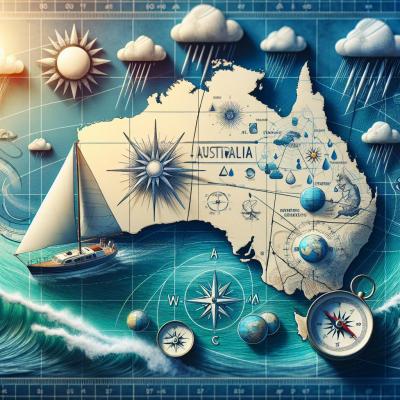Australian waters present a unique set of climate challenges that can range from sudden storms to unpredictable winds and high seas. Navigating these requires not just skill, but a keen comprehension of meteorological conditions. This is why weather literacy isn't just for meteorologists; it's a staple of marine safety that all boaters must prioritize.
In this article, we will embark on a journey of understanding—from interpreting weather maps to anticipating changes in the atmosphere, all tailored specifically for you, the Australian boater. Our voyage will cover the essentials tips and strategies for reading the sky and the sea. So anchor yourself in for an enlightening expedition into the world of weather patterns and safer boating practices.
The Basics of Marine Weather in Australia
Introduction to Australia's Coastal Weather Systems
Australia's marine climate is influenced by an array of oceanic and atmospheric systems, making it a unique challenge for boaters. The interaction between the warm waters of the surrounding oceans and the vast landmass conceives diverse weather conditions across different coasts. Understanding these systems is essential for safe and enjoyable boating.
Common Weather Phenomena Encountered by Boaters
When venturing out to sea, Australian mariners face a variety of weather phenomena. Among the most common are the refreshing sea breezes which offer a respite on hot days, yet can quickly escalate into gusty conditions. Conversely, the menace of thunderstorms, capable of unleashing high winds and heavy rains, frequently looms over seafarers, underscoring the importance of vigilance and preparedness.
Seasonal Weather Patterns and Their Impact on Boating
Boating in Australia is as much about timing as it is about skill. The country's weather patterns shift with the seasons, each bringing its own set of conditions. From summer's cyclones in the north, bringing heavy rains and strong winds, to winter's dominant high-pressure systems in the south, presenting colder temperatures and rough seas. Seasonal awareness can make all the difference between a tranquil sail and a trying ordeal on the water.
Weather Forecasting Resources
Top Sources for Marine Weather Forecasts in Australia
Australia's boaters have access to a wealth of resources for marine weather forecasts. The Bureau of Meteorology (BoM) is the foremost authority, providing detailed and up-to-date weather information. Their website offers area-specific forecasts, warnings, and satellite imagery crucial for maritime navigation. Additionally, Marine Rescue organizations and the Australian Volunteer Coast Guard are reliable sources that provide weather updates pertinent to boaters.
How to Interpret Weather Maps and Forecasts
Interpreting weather maps and forecasts is a vital skill for any boater. Weather maps display information such as high and low-pressure systems, frontal boundaries, and isobars—lines that indicate areas of equal atmospheric pressure. Learning to read these lines and symbols can help predict wind speed and direction, as well as storm paths. Forecasts often come with terminology like 'small craft advisory' or 'gale warning,' which serve as critical indicators for boaters to heed.
Utilizing Mobile Apps and Technology for Real-Time Updates
In the age of technology, staying informed has never been easier. Mobile apps and online tools can provide real-time weather updates and forecasts. Applications like WillyWeather, Windfinder, and the BoM's own app can push notifications about weather changes directly to your device. This convenience allows boaters to monitor conditions continuously and make informed decisions swiftly while at sea, ensuring their safety and that of their crew.
Planning Your Voyage
Incorporating Weather Considerations into Your Pre-Departure Checklist
Embarking on a marine journey without accounting for the weather is akin to setting sail without a compass. It's essential to integrate weather checks into your pre-departure routine. This includes analyzing up-to-the-minute forecasts, reviewing the potential for severe weather, and understanding wind patterns for the duration of your trip. Your checklist should also feature plans for safe harbor in case of unexpected weather changes and a review of safety equipment to ensure it's in working order.
Understanding the Limitations of Weather Predictions and the Importance of Flexibility
While technological advancements have greatly improved the accuracy of weather predictions, they are not infallible. Boaters should appreciate the inherent uncertainties and maintain a flexible attitude towards their travel plans. Decision-making agility comes from acknowledging that conditions can shift rapidly. Therefore, it is prudent to prepare for a range of scenarios and not be rigidly bound to your initially charted course.
Case Studies: Real-life Scenarios and Lessons Learned
Reflecting on past incidents provides invaluable insight for mariners. A case study involving an unexpected squall illustrates the necessity of having an evacuation plan and knowing when to use it. Another scenario, featuring a boater who narrowly escaped a severe storm by heeding a late forecast update, underlines the importance of continually monitoring weather conditions. These real-life experiences serve as a testament to the significance of weather awareness and preparedness.
Safety Measures During Sudden Weather Changes
Identifying Signs of Imminent Weather Changes While on the Water
Sharp observation and a deep understanding of nature's cues are crucial for identifying imminent weather changes at sea. As a seasoned boater, knowing to look for changes in wind patterns, cloud formations, and barometric pressure can give you the heads-up you need before conditions turn sour. Darkening skies, especially to the west, and a sudden drop in temperature may also indicate the swift approach of inclement weather. Stay alert for any unusual wildlife behavior as well, as animals often sense changes before humans do.
Immediate Actions to Take When Caught in Unexpected Bad Weather
Finding yourself in the middle of unexpected bad weather demands quick and decisive action. The first step is to ensure that everyone on board is wearing a life jacket. Reduce speed immediately and steer the vessel bow-first into waves at an angle to avoid being overpowered by the sea. If you're close to shore, seek refuge in the nearest safe harbor. Radio communication can also be a lifeline; use your VHF radio to inform authorities of your position and the situation. Maintaining calm is paramount, as panic can lead to poor decision-making.
Prepare by securing all loose items on the boat, closing any hatches, and readying pumps in case of water intrusion. It's also essential to have a ditch bag readily accessible containing critical survival items, in case abandoning ship becomes necessary.
Safety Equipment That Can Be Lifesaving During Severe Conditions
In the event of severe weather conditions, certain safety equipment onboard can mean the difference between life and death. It is essential to have a comprehensive safety kit, which includes items such as flares, emergency beacons (EPIRBs or PLBs), VHF radios, and extra batteries. A foghorn or signaling device can help alert nearby vessels to your location in reduced visibility. Moreover, a sturdy, well-maintained life raft should always be a part of your vessel's equipment, ready to deploy at any moment. Lastly, ensure that your navigation lights are functional and visible, as they are critical for preventing collisions during poor visibility.
Boating in Specific Weather Conditions
Navigational Tactics for High Winds and Rough Seas
Encountering high winds and rough seas requires a firm grasp of navigational tactics to maintain control of your vessel. First and foremost, reduce your speed to minimize the impact of waves and maintain maneuverability. Keep the boat's bow at an angle to the waves, which helps to reduce the chances of being swamped or capsized.
It is also advisable to distribute weight evenly and keep the heaviest gear low to maintain stability. Always stay aware of your surroundings, including other vessels, navigational hazards, and changes in water depth. Lastly, re-check your safety equipment before embarking if rough seas are likely – to ensure everything is in place and easily accessible.
Strategies for Boating in Heavy Rain and Reduced Visibility
Heavy rain can significantly reduce visibility and make navigation difficult. In such circumstances, your navigation lights should be on, even during the day, to make your vessel more visible to others. Reduce speed and use radar, if available, to monitor nearby traffic and potential obstacles. Utilize your GPS navigation system for positioning, and keep a close eye on buoyage to maintain awareness of your location.
Waterproof clothing will help keep you warm and dry, which is critical to maintain focus and prevent hypothermia. If visibility is too poor, consider anchoring in a safe location to wait out the weather. Your VHF radio will be essential in communicating with marinas, coast guard stations, and other vessels to inform them of your situation and intentions.
Tips for Dealing with Extreme Heat and Sun Exposure
Extreme heat and sun exposure present another set of challenges for Australian boaters. Ensure that you and your passengers are well-hydrated and apply broad-spectrum sunscreen regularly. Lightweight, long-sleeved clothing can provide protection from the sun's rays without causing overheating.
Consider installing a bimini or a canopy to create shade on your vessel, and remember to take regular breaks from the sun, especially during the peak hours of heat. Being on the water can exacerbate heat effects due to reflection, so monitoring everyone for signs of heat exhaustion or heat stroke is important. Finally, plan your trip to avoid the hottest parts of the day and be aware of the cooling effect of sea breezes which can occasionally mask the severity of the sun.
Emergency Preparedness and Response
Creating an Emergency Plan Tailored to Weather Risks
Every responsible boater must acknowledge the risks posed by the unpredictable weather and have an emergency plan in place. This plan should identify potential weather hazards you may encounter while boating, from high winds to thunderstorms, and detail specific actions to mitigate each risk. It should include evacuation routes, designated safe areas, and procedures for securing the boat and its equipment. One must tailor the emergency plan to both the vessel's capabilities and the experience level of its crew, aiming for the highest chance of safety and recovery.
Essential Safety Drills for the Crew: Man Overboard, Abandon Ship, and More
Conducting regular safety drills is essential in ensuring that the crew is prepared for emergency scenarios. Drills such as 'man overboard' teach everyone on board how to react swiftly and effectively to recover a person from the water. 'Abandon ship' drills train the crew in the proper and prompt deployment of life rafts and gathering of essential survival gear. It's also important to rehearse firefighting procedures, flooding control, and the use of communications equipment. Frequent drills will help reinforce these critical skills and ensure that each crew member knows their role during an actual emergency.
Communication Protocols for Alerting Authorities During Weather Emergencies
In a weather emergency, effective communication can save lives. It is vital to have a well-established protocol for alerting authorities. This should include knowing the emergency frequencies on your VHF radio, being proficient in radio communication procedures, and understanding the use of flares and signals for visual distress. In addition, a clear understanding of how to relay your position, the nature of the emergency, and the number of people on board will expedite the response. Keep a list of emergency contacts readily available, and educate all crew members on these protocols to ensure that anyone can call for help if the skipper is incapacitated.
Learning from Experience
How Seasoned Australian Boaters Handle Challenging Weather
Experience is a sailor’s best teacher, particularly when facing Australia’s capricious weather patterns. Seasoned Australian boaters possess an intimate knowledge of local conditions and are adept at adapting their strategies to the challenges presented by the weather. They prioritize safety, respect the power of nature, and use their experiences to inform future decision-making. Adept at reading the smallest signs of weather shifts, such experienced mariners adjust their sails and routes accordingly, often long before there's a palpable threat.
The Importance of Debriefing and Learning from Each Trip
Every voyage, whether smooth or fraught with adversity, provides invaluable lessons. Debriefing after each trip is a practice embraced by seasoned boaters to reflect on what went right and what could have been done better. This systematic approach to learning helps identify potential blind spots and reinforces good decision-making. By breaking down the events of the trip, boaters can analyze their responses to various weather scenarios, refining their skills and strategies for the future.
Encouraging a Culture of Safety and Learning Amongst the Boating Community
Fostering a culture of safety and learning is essential within the boating community. Seasoned boaters play a crucial role in championing this cause by sharing their experiences and insights with others. Clubs, associations, and informal gatherings serve as platforms for such exchange, creating a dialogue that elevates the collective knowledge and safety protocols followed. In this way, even those new to boating can benefit from the seasoned sailor’s experience, leading to a better-prepared and more resilient boating community.
Wrap-Up
Recap of Key Points on Weather-Savvy Boating
The essence of a safe boating experience in Australia is rooted in respecting and understanding the local weather patterns. We've traversed the significance of recognizing coastal weather systems, interpreting weather forecasts accurately, and choosing the right resources for real-time updates. We've highlighted the necessity of integrating weather considerations into your pre-departure checklist and the importance of planning with an allowance for unpredictability.
Moreover, we've discussed the immediate safety measures to undertake in the face of sudden adverse conditions and shared navigational tactics tailored to cope with various weather challenges such as high winds, heavy rain, and extreme sun. Finally, we emphasized the importance of emergency preparedness, the execution of safety drills, and effective communication during critical situations.
Continuously Educate and Prepare for Weather Conditions
As boaters, our education never ceases, especially when it comes to weather literacy. The ocean is a dynamic teacher that offers new lessons with each venture. It's essential to remain students of the sea, continuously updating our knowledge and skills. Staying abreast of the latest technological advancements in weather forecasting and participating in safety courses will further enhance our preparation for facing the weather's unpredictability.
Engage with Other Boaters, Share Experiences, and Stay Informed
In the spirit of camaraderie that pervades the boating community, let us reach out and engage with fellow seafarers. Share your experiences and learn from theirs. Make it a point to attend community events, engage in online forums, and contribute to discussions on weather patterns and boating. Together, we can fortify our knowledge base, sharpen our safety practices, and ensure that each time we set sail, we are as prepared as we can be for whatever the weather might bring.
Let us commit to staying informed, prepared, and connected. May our collective efforts lead to safer and more enjoyable maritime adventures. Check your resources regularly, keep your knowledge current, and share the wisdom of experience. Fair winds and following seas!
Additional Resources
Links to Further Reading on Marine Weather and Boating Safety
Enhancing your understanding of marine weather and boating safety is an ongoing process that can be facilitated by a variety of resources. Websites such as the Bureau of Meteorology (BoM) offer extensive material on Australia's specific weather phenomena. For a global perspective, websites like the World Meteorological Organization (WMO) provide a treasure trove of information valuable for any seafarer.
Safety guides and educational materials are regularly updated by organizations such as Australian Maritime Safety Authority (AMSA) that can be studied to maintain best practices aboard your boat.
Government and Non-profit Organizations Dedicated to Boater Education
Governments and non-profit organizations play a pivotal role in ensuring that boaters are well-informed and equipped to handle the challenges posed by the sea. In Australia, AMSA and Maritime Safety Queensland (MSQ) lead this front with educational programs, licensing information, and safety regulations. Non-profits like the Royal Life Saving Society Australia work tirelessly to prevent accidents through training and education for boaters of all experience levels.
Community Forums for Australian Boaters to Connect and Exchange Information
Being a part of a community can significantly enhance your readiness and response to marine weather challenges. Online platforms such as The Australian Boating Forum or the Yachting and Boating World forums act as excellent meeting grounds for exchanging ideas, discussing weather incidents, and seeking the advice of seasoned mariners. Engaging with local clubs and attending events can also provide hands-on experiences and foster connections that can be invaluable sources of support and knowledge.
Last updated: Monday 1st January, 2024









